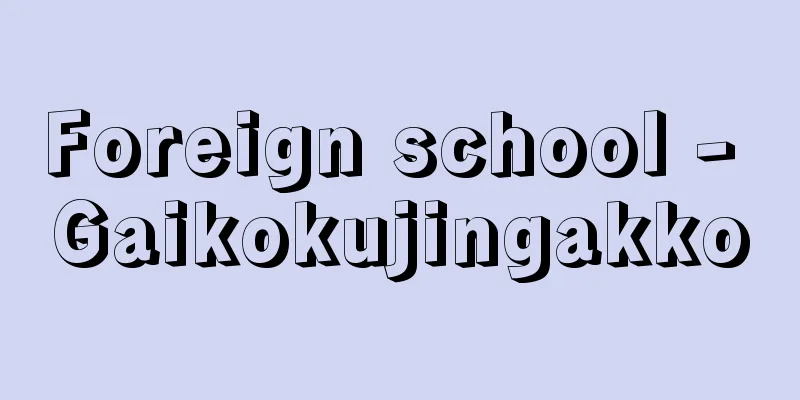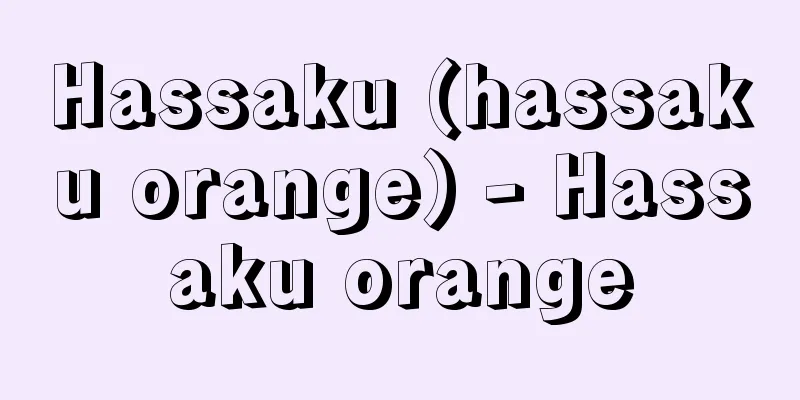Foreign school - Gaikokujingakko

|
This refers to a school whose purpose is to educate the children of foreigners. There are several types of foreign schools: [Toshiaki Kuwahara and Yoshinori Hirose] historyThe history of foreign schools in Japan began with the Dame de Saint-Maur School, which was established in Yokohama in 1872 (Meiji 5) (approved as a miscellaneous school in 1899), and many more were opened in Yokohama, Tokyo and Kobe for Western foreigners, including St. Joseph's School (Yokohama) founded in 1901 (Meiji 34) and the American School founded in 1902. After the Sino-Japanese War, students from China were accepted and special schools were established for them, but in 1924 (Taisho 13), the various schools for Chinese were merged to form the Chinese Public School. [Toshiaki Kuwahara and Yoshinori Hirose] The issue of Korean schools in JapanThese pre-World War II foreign schools continued to exist after the war, but a new situation arose with the independence of Korea. In other words, the majority of foreign schools in Japan after the war were Korean schools. This was because, although independence from Japanese colonial rule had been achieved at the time, many Koreans remained in Japan, facing the division and turmoil of their homeland as a result of the Cold War, when Korea (the Republic of Korea) was founded in August 1948 (Showa 23) and the Democratic People's Republic of Korea was proclaimed in September. Within a few years of the defeat, Koreans in Japan, seeking to restore ethnic education, established Korean schools all over the country, and as of October 1947 there were 541 Korean elementary schools, 7 middle schools, 22 youth schools, and 8 high schools. However, as a result of the Hanshin Education Incident in 1948, the number of schools nationwide dropped sharply to as low as 44 (1952). Later, through independent school revitalization efforts in the 1950s and 1960s, the total number of schools had risen to 142, including one Korea University, by 1966. Since then, the number has remained at around 150, but has been declining in recent years. As of 2006, there are 79 Korean schools approved as miscellaneous schools. The Japanese government concluded the Treaty on Basic Relations between Japan and the Republic of Korea in 1965, but relations with North Korea did not improve, and the government adopted a policy of not authorizing foreign schools as miscellaneous schools, so the remaining schools continued to operate independently. However, after the Treaty on Basic Relations between Japan and the Republic of Korea was concluded, prefectural governors, who had the authority to grant approval, gradually accepted the requests of Koreans in various regions and authorized schools as miscellaneous schools as stipulated in Article 83 of the School Education Law (at the time), and about 80% of the approvals were concentrated between 1966 and 1971. In response, the Japanese government submitted three bills to the Diet between 1966 and 1968 to separate foreign schools from miscellaneous schools, the so-called Foreign School Bill. All of these bills were rejected, but at the time the Ministry of Education instructed prefectural governors to emphasize its previous policy, stating, "Korean schools, whose purpose is to cultivate Korean ethnicity or national character, are not recognized as having positive significance in our society that would warrant the status of miscellaneous schools, and therefore should not be approved as miscellaneous schools" (Administrative Vice-Minister's Notice dated December 28, 1965). However, unless the organizational purpose of the school is to provide education that violates domestic law, this notice does not necessarily prohibit foreign schools from educating anyone, nor is it an order to revoke the approval of schools that have already been approved as miscellaneous schools. Therefore, there are still two types of foreign schools today: approved and unapproved. [Toshiaki Kuwahara and Yoshinori Hirose] Article 1 School Approval IssuesOn a related note, Tokyo Metropolitan International High School was established in April 1989 after about three years of preparation by the Tokyo Metropolitan Board of Education in response to the proposal for an "internationally open school" in the Temporary Education Council's report (1987). Unlike the dozen or so other international schools established in the country, Tokyo Metropolitan International High School is a new international school established as a "school" as defined in Article 1 of the School Education Law in order to enable students to advance to national or public higher schools, and its students are made up of ordinary Japanese people as well as children of returnees and foreigners living in Tokyo. Also, of the four Korean ethnic schools in the country, Hakuto Academy (Konkuk School) and Kongo Gakuen in Osaka are rare examples of foreign schools that have been approved as Article 1 schools. The remaining two schools, Tokyo Korean School and Kyoto Korean School, are approved as miscellaneous schools, like the majority of foreign schools. Currently, Korean schools, which are managed independently as miscellaneous schools, are not given the right to enter national or public higher schools, and are facing financial difficulties due to the lack of public subsidies. In order to improve the disadvantages that come with the status of miscellaneous schools, there are many voices calling for recognition as Article 1 schools or treatment equivalent to that. In relation to this, in 1998, the Japan Federation of Bar Associations recommended that Korean school students be allowed to enter national universities. Incidentally, among private and public universities other than national universities, 34 out of 66 public universities (51.5%) and 228 out of 457 private universities (49.9%) legally recognize the eligibility to enter universities to students from foreign schools such as Korean high schools, Korean schools, and Chinese schools, based on the application of Article 90 of the School Education Law and Article 150 of its Enforcement Regulations (as of 2000, according to a survey by the National Liaison Council for the Improvement of Treatment of Ethnic Schools). [Toshiaki Kuwahara and Yoshinori Hirose] New developmentsToday, more active legal and administrative support is required for foreign schools, both from the perspective of ensuring the right and opportunity to learn their mother tongue and mother culture, as recognized under international human rights law, and from the perspective of promoting educational and cultural exchange and multicultural and ethnic coexistence education appropriate to the age of globalization. In this regard, since graduates of foreign schools as miscellaneous schools are not recognized as junior high school or high school graduates, an increasing number of people are obtaining university entrance qualifications by taking the high school graduation equivalency exam (high school graduation certification), and it is noteworthy that there is a movement to actively recognize this. In addition, in 1981, foreign high school students attending Japanese schools in Japan were able to participate in the National Athletic Meet, and in 1991, the Japan High School Athletic Federation and the Japan High School Baseball Federation, the latter of the two major organizations that had not previously allowed membership, announced a policy to allow Korean schools to officially join and participate in tournaments, and some movements are being seen that are in line with the above perspective. [Toshiaki Kuwahara and Yoshinori Hirose] "A Theory of Education for Koreans in Japan" by Ozawa Yusaku (1973, Aki Shobo)" ▽ "The Treatment of Korean Schools Questioned" by Park Sam-seok (1992, Chosen Seinensha)" ▽ "Multiculturalism and Multicultural Education" edited by Hirota Yasuo (1996, Akashi Shoten)" ▽ "Ethnic Education in the Age of Globalization - Children Build a Rainbow Bridge" by Ko Chan-yu (1996, Toho Publishing)" ▽ "Compilation of Materials Related to Koreans in Japan, Postwar Edition, Vol. 7, Related to Tokyo Metropolitan Korean Schools" by Park Kyung-sik (2000, Fuji Publishing) [Reference items] | | | |Source: Shogakukan Encyclopedia Nipponica About Encyclopedia Nipponica Information | Legend |
|
外国人の子供の教育を目的とする学校をいう。このような外国人学校には、 [桑原敏明・広瀬義徳] 歴史日本における外国人学校の歴史は、1872年(明治5)横浜に設置されたダームドサンモール校(1899年各種学校として認可)に始まり、1901年(明治34)設立のセントジョセフ校(横浜)、1902年設立のアメリカン・スクールなど欧米系外国人対象に、横浜、東京、神戸に多く開設された。日清(にっしん)戦争後は、清国留学生が受け入れられ、そのための特別学校も設けられたが、1924年(大正13)中華公立学校として中国人のための諸学校が併合された。 [桑原敏明・広瀬義徳] 在日朝鮮人学校問題これら第二次世界大戦前の外国人学校は戦後も存続したが、朝鮮の独立により新たな局面を迎えた。すなわち、戦後の日本国内の外国人学校は、朝鮮人学校が大多数を占めることになったが、それは、当時、日本の植民地支配から独立は達成されたものの、東西冷戦の影響を受けて、1948年(昭和23)8月に韓国(大韓民国)が創建、次いで9月には朝鮮民主主義人民共和国が創建を宣布されるという祖国の分断と混乱に直面した朝鮮人が多数残留したためである。敗戦後数年間のうちに、民族教育の回復を求めた在日朝鮮人は朝鮮人学校を全国各地に創設し、1947年10月時点で、朝鮮初級学校541校、中学校7校、青年学校22校、高等学校8校が存在した。しかし、1948年の阪神教育事件の結果、一時期全国で44校(1952)にまで激減。その後1950年代~60年代における自主的な学校再生の取組みにより、1966年には、朝鮮大学校1校を含めて、総数142校にまで立て直しを図った。以後、約150校前後を推移したが近年は減少傾向にある。各種学校として認可されている朝鮮人学校は2006年現在79校である。 日本政府は、1965年(昭和40)に日韓基本条約を締結するが、北朝鮮との関係は改善されず、外国人学校も各種学校として認可しない方針をとったため、その残りが自主的学校運営を続けた。ただ、日韓基本条約締結以後は、認可権限を有する都道府県知事が、各地で朝鮮人の要求を受け入れる形で、学校教育法第83条(当時)の規定する各種学校として漸次認可していくようになったため、認可取得の約8割が1966年から1971年の間に集中した。 対して、日本政府は1966年(昭和41)から1968年にかけて、各種学校から外国人学校を分離する、いわゆる外国人学校法案を国会に三度上程した。これらはいずれも廃案となったが、当時文部省は「朝鮮人としての民族性または国民性を涵養(かんよう)することを目的とする朝鮮人学校は、わが国の社会にとって、各種学校の地位を与える積極的意義を有するものとは認めないので、これを各種学校として認可すべきでない」(1965年12月28日付事務次官通達)という、従来の方針を強調する内容の指導を都道府県知事に対して行った。しかし、事実上、国内法に抵触する教育を組織運営の目的としているのでない限り、この通達は外国人学校の教育を一律禁止するものではなく、すでに認可済みの学校から各種学校としての認可を取り消す命令でもない。そのため外国人学校には、現在でも認可校と無認可校の2種類がある。 [桑原敏明・広瀬義徳] 1条学校認可問題なお、関連していえば、臨時教育審議会答申(1987)における「国際的に開かれた学校」の提案を受けて、東京都教育委員会が約3年の準備期間ののち、1989年(平成1)4月に設立した東京都立国際高等学校は、国内に設置されているその他十数校の国際学校と異なり、国公立上級学校への進学を可能とすべく、学校教育法の第1条に定める「学校」として創設された新しい国際学校で、生徒は一般日本人のほか、帰国子女や在京外国人で構成されている。また、全国に4校ある韓国系の民族学校のうち、大阪の白頭(はくとう)学院(建国学校)と金剛学園も、外国人学校ながら、1条学校としての認可を受けている数少ない例としてあげられる。残る東京韓国学校と京都韓国学校の2校は、大部分の外国人学校と同様、各種学校としての認可である。 現在では、各種学校として自主的な学校運営を実施している朝鮮人学校には、国公立上級学校への入学資格が付与されない問題や公的助成金が少ないための経営難などの事情から、各種学校の地位に由来する不利益の改善を求めて、1条学校への認可、あるいはそれに準ずる処遇を求める声も少なくない。この点とかかわって、1998年(平成10)、日本弁護士連合会が、朝鮮人学校生徒の国立大学への門戸開放を勧告している。ちなみに、国立を除く私立・公立大学で、法規上、学校教育法第90条および同施行規則第150条の適用を根拠として、朝鮮高級学校、韓国学校、中華学校等の外国人学校出身者への大学入学資格を認めている学校は、公立大学で66校中34校(51.5%)、私立大学で457校中228校(49.9%)存在している(2000年現在。「民族学校の処遇改善を求める全国連絡協議会」調査による)。 [桑原敏明・広瀬義徳] 新たな動き今日、外国人学校は、国際人権法上認められている母語・母文化を学習する権利・機会保障の観点からも、また、国際化時代にふさわしい教育文化交流や多文化・民族共生教育の促進の観点からも、より積極的な法的・行政的援助が求められている。その点、各種学校としての外国人学校卒業者には中卒・高卒の資格が認められていないため、高等学校卒業程度認定試験(高卒認定)を利用して大学入学資格を取得する者が増えており、それを積極的に公認していこうとする動きがあることは注目される。また、1981年(昭和56)には、日本の学校に通う在日外国人高校生の国民体育大会への参加が実現し、1991年には、従来加盟を認めていなかった日本高等学校体育連盟と日本高等学校野球連盟の二大団体のうち後者が、朝鮮人学校の正式な加盟と大会参加を認める方針を打ち出すなど、前記の観点にかなった動きも一部ではみられるようになっている。 [桑原敏明・広瀬義徳] 『小沢有作著『在日朝鮮人教育論』(1973・亜紀書房)』▽『朴三石著『問われる朝鮮人学校処遇』(1992・朝鮮青年社)』▽『広田康生編『多文化主義と多文化教育』(1996・明石書店)』▽『高賛侑著『国際化時代の民族教育――子どもたちは虹の橋をかける』(1996・東方出版)』▽『朴慶植著『在日朝鮮人関係資料集成 戦後編 第7巻 都立朝鮮人学校関係』(2000・不二出版)』 [参照項目] | | | |出典 小学館 日本大百科全書(ニッポニカ)日本大百科全書(ニッポニカ)について 情報 | 凡例 |
<<: Voting rights for foreigners
>>: Foreigner - gaikokujin (English spelling) foreigner
Recommend
Abdera - Abdera (English spelling)
An ancient Greek polis (city-state) located in th...
Analog Servo - Analog Servo
...However, it is difficult to realize a powerful...
"Umeyasu General Dog Warrior Tournament" - Umeyasu General Dog Warrior Tournament
...Other plays include the play "Keisei Eigh...
Appennino Tunnel (English name) Galleria dell'Appennino
A railway tunnel that crosses the Apennine Mountai...
"Eternal Music Variations"
...Kumiuta koto music is considered to have origi...
Shinetsu Main Line - Shinetsu Main Line
The name of the East Japan Railway Company (JR Ea...
Hamagou - Hamagou
A coastal shrub of the Verbenaceae family (APG cl...
No. 1 Ship Bottom Paint - Ichigo Ship Bottom Paint
...paint used on steel ships to prevent corrosion...
Hu Wei-yong (English spelling)
[raw]? Died in 1380. A politician from the early M...
Pilgrimage - Junshu (English spelling) xun-shou; hsün-shou
Also written as 'Shunshu'. In ancient Chin...
Francis Hutcheson
A representative philosopher of the 18th century ...
Between words - Talking
...The most common form is a role that connects t...
Asimidel
…There are many prehistoric rock paintings. The m...
Siberian bighorn (English spelling)
…Also called bighorn sheep, it is a sheep with la...
Parentheses
...The marks used to indicate the break between p...

![Yuu [town] - Yuu](/upload/images/67cd10d50f74d.webp)






![Takase [Hot Spring] - Takase](/upload/images/67cc1d399f285.webp)
